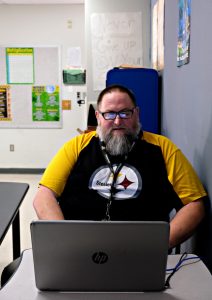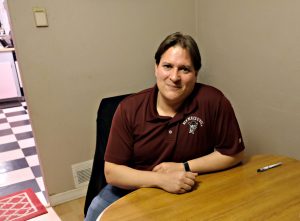By Sylvia Ulloa / New Mexico In Depth
For the first time in three years, the number of classrooms missing a teacher fell in New Mexico rather than increased. It was so hopeful a sign Gov. Michelle Lujan Grisham bragged about the 13% drop in teacher vacancies in her State of the State speech.
It’s pretty simple math — this school year 89 school districts across New Mexico couldn’t fill 644 teaching slots, while in 2018, that number was 740.
But the state teacher shortage is deeper and more complicated than a tally of open teaching positions around the state, with superintendents performing calculus to figure out how best to meet the needs of students.
Data from the Public Education Department shows skyrocketing numbers of people with bachelor’s degrees stepping into classrooms without teacher training. It’s a trend that syncs with a drop in the number of teaching candidates emerging from the state’s university education departments. But those teachers quit at much higher rates than traditionally trained teachers because, and like many beginning educators, they don’t feel properly supported for the rigors of the job.
The teacher shortage plays out in the day-to-day lives of students through larger class sizes in some schools, combined grades in rural areas, fewer electives and more online classes.

“It’s very district and region specific,” Karen Trujillo, superintendent of Las Cruces Public Schools and former New Mexico secretary of education, said about how the state’s teacher shortage affects classrooms.
Trujillo created the annual New Mexico Educator Vacancy Report in 2015 when she was a researcher at New Mexico State University. As an example of how the teacher shortage affects small school districts more than it might large districts, she described a high school with just one teacher trained to teach English learners. “If that teacher retires, the chances of that district finding an ELL teacher, just because there are not very many out on the market, are slim to none.”
If the New Mexico Legislature and Lujan Grisham are going to reverse the state’s teacher shortage, they will need an array of approaches to recruit and keep teachers from New Mexico, education advocates say.
Lawmakers are pushing a second straight year of salary increases, proposing 5% raises in the draft state budget that heads to the Senate this week. They’re also looking at funding programs that support teachers in their first few years in the classroom, and that make teaching degrees more attractive and inexpensive for New Mexicans.
“You have to be creative, and in the end, you have to put the best people in front of kids and give them the proper support that they need to succeed,” Trujillo said.
***
Paul Ebell and Brook Stockberger got their start in education through alternative licenses. Like many career-switchers in New Mexico schools, they’re taking up hard-to-fill positions. Ebell teaches math at Hatch Valley High School. Stockberger supports special education students at Vista Middle School in Las Cruces.
The use of alternative teacher licenses — two- to three-year temporary licenses where college graduates without teaching degrees begin careers in the classroom while they take education classes — has surged as the teacher shortage crisis has deepened in New Mexico. There were 466 teachers on alternative licenses in 2014, according to PED data. This school year it was 2,352, or about one in 10 teachers in the state.
![]()
Ebell and Stockberger work in school districts that are heavily Hispanic and low-income. That’s pretty typical.
Schools with a high number of students of color have twice as many uncertified teachers and 50% more inexperienced teachers, Linda Darling-Hammond of the Learning Policy Institute told lawmakers in November when presenting recommendations for how to ease the state’s teacher vacancy problem.
At Hatch Valley Public Schools, where 95% of students are Hispanic and nearly all low-income, 15 of its 82 teachers are on alternative licenses or are long-term substitutes — nearly one in five teachers.

Teachers with alternative licenses fill a critical need because education colleges no longer graduate enough people to replace the ones who retire, leave the state or just up and quit. In 2009, New Mexico’s two- and four-year public colleges graduated 1,228 teachers, according to the NMSU Educator Vacancy Report. Last year the number who graduated was 746 — while the state lost 1,455 teachers, the PED reported.
Alternatively licensed teachers quit teaching at two to three times the rate of traditionally trained teachers in the early years of their classroom careers, Darling-Hammond told lawmakers in November.
She’s a national expert in teacher turnover and has written several reports on how to address the problem. The high turnover creates challenges for rural districts and poor, low-performing schools that regularly grapple with new hiring cycles and inexperienced teachers.
The litany of reasons for the exodus of teachers will sound familiar. NMSU acting Education Dean Susan Brown said low pay, a “blame game” against schools and teachers for the state’s low education ranking, and reliance on high stakes testing have driven people out of public schools and deterred others from entering.
“We’ve got fantastic teachers,” Brown said. “Sometimes you have to let them have a little free rein and not them be so controlled by teaching to the test.
***
Preliminary findings from a report about the teacher shortage by the Los Alamos National Labs Foundation revealed that few students are considering careers in education and many inexperienced teachers aren’t getting meaningful support.
After conducting surveys and focus groups with more than 750 teachers and 500 students from a seven-county region in north-central New Mexico that includes 12 small, rural districts, six medium-sized districts and two urban districts — Rio Rancho and Santa Fe — researcher Kersti Tyson of the LANL Foundation said New Mexico can take several steps to dig out of its educator hole.
LANL’s preliminary report suggests the state build a statewide teacher recruitment program with career classes for high-schoolers interested in becoming teachers. It also recommended removing some of the financial barriers to getting a degree in education by providing full scholarships, paying education students for the semester they must practice teaching at local schools, and having the state or school districts pick up the tab for background checks and licensing paperwork.
And when teachers enter the classroom — especially teachers who get into teaching on an alternative license — give them an intensive, state-financed new teacher training program to ease them through those difficult first few years, the report suggests.
Teachers said in focus groups that better pay was important, but it wasn’t everything, Tyson reported. They said they had entered the field because they enjoyed working with children and wanted to make a difference.
“The state probably won’t be the highest paying, but what if it was the best place to work as a teacher?” Tyson said. “What are the things we could put in place to help it be a place where teachers are thriving? Because we know that if teachers are thriving, then students are thriving in schools.”
The LANL Foundation talked with mostly new and alternative licensed teachers and found that many felt unprepared and needed more help for simple things like recording attendance and grades, and more guidance in classic teaching skills like classroom management, lesson planning, assessing students and building relationships with students and parents.
Ebell can relate.
“It was a struggle for sure,” Ebell said of his first year as a teacher. “I didn’t have experience with student teaching. I’d never done that. Lesson planning. I’d never done a lesson plan. And that’s not really part of the alternative program that much.”
Tyson said a common thread among the new teachers was a desire for someone to show them the ropes.
“And that is available in some places, but not other places,” she said, even though New Mexico requires that new teachers get mentors. New teacher programs are not consistently funded or monitored, Tyson said. Some master teachers are paid extra to mentor, but many are not, and they don’t get dedicated time to help their new colleagues.
Despite the challenges, Tyson noted, most teachers surveyed were happy about their career choice.
“It’s very hard, but I like it,” Stockburger said. “Everyone keeps saying, ‘so are you going to try to get into a regular classroom?’ But I said, no, I’m going to stay in special ed.”
Ebell also found his new profession satisfying. Four years into his teaching career, he feels on firmer ground. “My classroom management has gotten 10-fold better,” he said.

***
Adults may think teens aren’t listening to them, but New Mexico students have gotten the word on the teaching profession. Most students who took part in the LANL focus groups said they planned to go to college, but few considered becoming a teacher. They cited the low pay, especially when paired with the stress they believed came with the job.
“The students are very aware of that whole picture,” said Charles Goodmacher, a teachers union lobbyist and consultant who helped conduct the focus groups.
As one student told interviewers: “I don’t want to be a teacher because if students like me and my friends were in my class, I wouldn’t be able to handle us.”
The majority of the students interviewed also said teachers weren’t respected. Most said no one had talked to them about becoming a teacher, and those who had were discouraging.
Goodmacher described one longtime teacher who became tearful because her son, who was great at math, had talked to her excitedly about becoming a teacher. “She said to him, you know, I don’t advise it. I love you, ‘jito, but you’re not going to be able to support a family on a teacher’s salary.”
But after changes in the past legislative session, NMSU’s Brown sees a shift in attitudes — and an increase in enrollment. The PED has moved away from some of its high-stakes testing and the state is investing in new, better-trained teachers and paying them more, things she hopes the New Mexico Legislature will expand on this year.
In 2019, the Legislature gave NMSU’s College of Education enough money for 30 teachers to earn a master’s degree in STEM education. It got 85 applicants. The college also received $700,000 in scholarship money for aspiring teachers and has already given out $600,000, Brown said. The scholarships are prominently displayed on the school’s website.
“There is a lot of hope going on. There’s a lot of things that are happening that are very positive,” she said.
The Legislature is proposing 5% across the board raises. But advocates and educators want much more. A group of teachers unions, superintendent, school board and PTA associations, called Education Partners, wants a 10% raise for educators, as does the Transform Education New Mexico coalition that came out of the Yazzie Martinez education lawsuit.
Research is mixed on the link between higher pay and student success, but a 2014 study of teacher pay in Texas found a direct link between higher pay and lower turnover. And other research has shown it attracts high-achieving college students and increases the likelihood of hiring teachers who earned top scores on their educator certification exams.
Lawmakers are also seeking funds for teacher residency and mentorship programs. They’re being asked to fund changes at teacher’s colleges across the state that would integrate bilingual and TESOL (Teaching English to Speakers of Other Languages) training into undergraduate education degrees and bolster the state’s regional professional development centers with $2.6 million to provide more training on multicultural education.
The problem is deep, but not insurmountable, Darling-Hammond told members of the Legislative Education Study Committee in November.
“I have seen states eliminate teacher shortages in as little as three years with a very purposeful approach,” she said.
